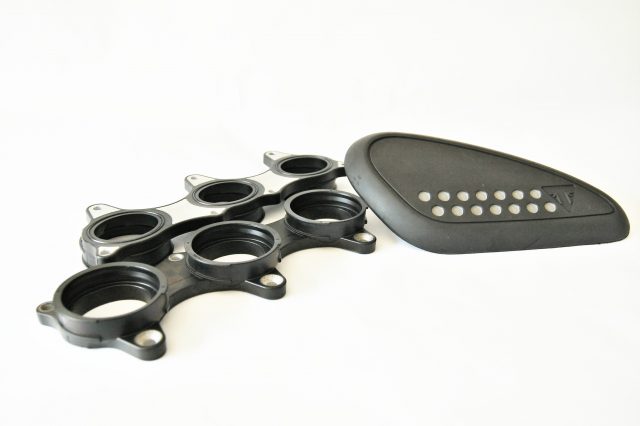Process
- Compression Moulding and Transfer Moulding
Compression molding consists of placing a pre-formed piece of the mix in the cavities of the mold heated by the press plates. Transfer molding consists of placing a piece of rubber in a heated shooting pot which, by the effect of compression when the mold is closed, transfers the material in the mold cavities.

- Injection Moulding
The injection molding method consists in plasticizing a specific volume of injected mix under a rotating screw (shear). Pushed by the screw movement, this pressurized plasticized mix continuously enters the flow outlet (nozzle). Then, the plasticized mix enters the injection head to reach the mold cavities to shape the product. When the vulcanization (curing) is completed, the part is removed from the cavity and then deflashed to remove excess rubber.Our facilities and services allow us to produce parts of different sizes and complexities with various types of rubber and silicone, whether colored or black.

- Liquid Silicone
Liquid Silicone molding method consists on injecting two mixes of liquid silicone into the mould. It offers high purity silicone, great stability and ability to resist extreme temperatures both hot and cold. It is ideal for some types high quality parts such as high voltage isolators, medical equipment, food application, bathroom appliances, etc.

- Material Preparation
Our mixing equipment and performer allows us to precisely prepare rubber pre-forms and strips. Material preparation is key to assure quality and allows for high efficiency production.

- Polymer Engineering and Chemistry
Through our Group’s 45 years experience in developing rubber compounds and its formulation database, Soucy Shanghai can meet your project’s technical requirements pertaining to manufacturing costs or project complexity. We have the expertise to determine the type of elastomer, and its composition and additives required to meet the specific needs of your application. We can also use an existing formulation when its properties correspond to the specifications of the desired part.Our expertise is in all types of rubber including Natural Rubber (NR), EPDM, Nitrile Rubber (NBR), Fluoroelastomers (FKM), Silicone (SI, Q, MVQ), Epichlorohydrin Rubber (ECO), Chloroprene (CR), SBR, etc.

- Design of Components
The engineering department efficiently leads each component design and equipment development projects in both the Canadian and the Chinese facilities. If necessary, this service will propose improvements to the concept to reduce costs and increase part performance. In accordance with our standards of quality, formulations and products are first tested in the laboratory and then on site in a production environment, with an iterative improvement process if required.To complete its component design service, Soucy Baron (Canada) offers 3D prototype printing for quick, efficient and cost-effective modeling verification.

- NVH: Noise, Vibration & Harshness Control
Applications in the NVH field are numerous; one example that benefits greatly from our science is the engine mount, since this component isolates the chassis from engine vibration.We helped Power Sport main OEMs develop and design rubber parts to control NVH (Noise, Vibration & Harshness). We became their strategic partner, manufacturing the majority of these parts.

- Overmolding and Bonding
Soucy Shanghai strong expertise in overmolding and bonding techniques. Overmolding consists of coating a metal or plastic insert with an elastomer, while bonding is used to combine the mechanical strength of a rigid structure (metal or plastic insert) with the flexible characteristics of rubber. To do this, the insert is first sanded and coated with adhesive that is sprayed manually or automatically on the surface to be in contact with the elastomer. This bonding creates much more efficient systems than simple assembly. The bonding reaction occurs during overmolding, which can be done by compression, injection or transfer. The overmolding reduces costs by eliminating the extra steps of assembly and finishing. In addition, this method improves the part’s watertightness and damping properties, while respecting the target physical and mechanical properties depending on the part application.
